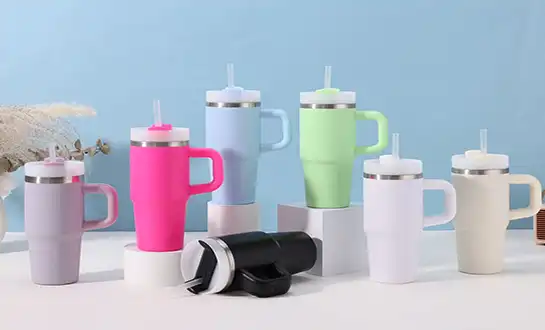The Beginner’s Guide to Stainless Steel Vacuum Flask
In today's fast-paced world, maintaining proper hydration while keeping beverages at the perfect temperature has become essential for health-conscious individuals and busy professionals alike. The Stainless Steel Vacuum Flask represents a revolutionary advancement in drinkware technology, combining superior insulation properties with durable construction to deliver exceptional performance. This comprehensive guide explores everything you need to know about stainless steel vacuum flasks, from their innovative double-wall construction and vacuum insulation technology to practical considerations for daily use. Whether you're a fitness enthusiast seeking to keep your water ice-cold during intense workouts, a coffee lover wanting to maintain that perfect brewing temperature throughout your commute, or an outdoor adventurer requiring reliable hydration solutions, understanding the fundamentals of Stainless Steel Vacuum Flask technology will empower you to make informed decisions and maximize your investment in quality drinkware.
Understanding the Science Behind Stainless Steel Vacuum Flask Technology
The Physics of Vacuum Insulation in Modern Flask Design
The remarkable performance of a Stainless Steel Vacuum Flask stems from its sophisticated engineering that harnesses fundamental principles of heat transfer prevention. The vacuum insulation technology creates an airless space between two stainless steel walls, effectively eliminating heat transfer through convection and conduction. This scientific approach ensures that hot beverages remain steaming for up to 12 hours while cold drinks stay refreshingly chilled for 24 hours or more. The absence of air molecules in the vacuum space prevents thermal energy from moving between the inner and outer walls, creating an almost perfect thermal barrier. Modern Stainless Steel Vacuum Flask designs incorporate advanced manufacturing techniques that achieve vacuum levels approaching 10^-4 torr, which represents an extremely low-pressure environment where heat transfer becomes virtually impossible. This precision engineering distinguishes premium vacuum flasks from ordinary insulated bottles, delivering consistent temperature retention that meets the demands of professional applications and everyday use.
Material Science and Stainless Steel Grade Selection
The choice of stainless steel grade significantly impacts the performance and longevity of your Stainless Steel Vacuum Flask. Food-grade 304 stainless steel, commonly used in premium flask construction, contains 18% chromium and 8% nickel, providing excellent corrosion resistance and maintaining flavor neutrality for all beverages. This austenitic stainless steel grade exhibits superior formability during manufacturing, allowing for seamless construction of complex flask geometries without compromising structural integrity. The non-reactive nature of 304 stainless steel ensures that acidic beverages like citrus juices or coffee maintain their original taste profile without metallic aftertastes or chemical interactions. Advanced Stainless Steel Vacuum Flask models may utilize 316 stainless steel, which incorporates molybdenum for enhanced corrosion resistance in marine environments or industrial applications. The molecular structure of these stainless steel grades provides natural antimicrobial properties, reducing bacterial growth and maintaining beverage hygiene during extended storage periods. Understanding these material characteristics helps consumers appreciate the engineering excellence behind premium vacuum flask performance.
Advanced Manufacturing Techniques for Superior Performance
Contemporary Stainless Steel Vacuum Flask production employs sophisticated manufacturing processes that ensure consistent quality and optimal thermal performance. Deep drawing techniques shape the inner and outer vessel walls from single stainless steel sheets, eliminating potential weak points that could compromise vacuum integrity. Precision welding technologies create hermetic seals at critical junction points, maintaining the vacuum environment throughout the product lifecycle. Computer-controlled evacuation processes remove air molecules from the inter-wall space, achieving vacuum levels that maximize insulation efficiency. Quality control systems monitor vacuum integrity through helium leak detection, ensuring each Stainless Steel Vacuum Flask meets stringent performance standards before packaging. Surface finishing processes, including electropolishing and passivation treatments, enhance corrosion resistance while creating smooth, easy-to-clean interior surfaces. These manufacturing innovations represent decades of technological advancement, resulting in vacuum flasks that deliver reliable performance under diverse operating conditions while maintaining aesthetic appeal and functional durability.
Essential Features and Design Elements of Quality Vacuum Flasks
Innovative Lid Technologies and Sealing Mechanisms
The lid system represents a critical component in Stainless Steel Vacuum Flask performance, serving as the primary interface between the vacuum-insulated chamber and the external environment. Advanced lid designs incorporate multiple sealing elements, including food-grade silicone gaskets and precision-machined threading systems that prevent air infiltration and maintain optimal vacuum integrity. Modern Stainless Steel Vacuum Flask lids feature ergonomic designs that facilitate one-handed operation while providing secure closure mechanisms that prevent accidental opening during transport. Some premium models integrate leak-proof locking mechanisms that engage through quarter-turn or push-button systems, offering enhanced security for active lifestyles. Temperature-resistant materials in lid construction ensure that extreme hot or cold beverages don't compromise sealing performance or create safety hazards during use. Ventilation systems in specialized lids allow controlled pressure release when necessary, preventing dangerous pressure buildup while maintaining thermal performance. The integration of drinking spouts, straws, or wide-mouth openings provides versatility for different beverage types and consumption preferences, making the Stainless Steel Vacuum Flask suitable for diverse applications from office environments to outdoor adventures.
Capacity Options and Ergonomic Considerations
Selecting the appropriate capacity for your Stainless Steel Vacuum Flask requires careful consideration of intended use patterns, portability requirements, and thermal performance characteristics. Standard capacity options range from compact 12-ounce models designed for coffee enthusiasts to large 64-ounce versions suitable for extended outdoor activities or office environments. The relationship between flask capacity and thermal retention follows specific engineering principles, where larger volumes generally maintain temperature longer due to reduced surface-area-to-volume ratios. Ergonomic design considerations in Stainless Steel Vacuum Flask construction include bottle diameter, weight distribution, and grip textures that enhance user comfort during extended carrying or frequent use. Narrow-mouth designs optimize thermal retention and pouring control, while wide-mouth configurations facilitate ice insertion and thorough cleaning procedures. Weight optimization through advanced manufacturing techniques ensures that larger capacity models remain portable without compromising durability or thermal performance. Professional users often prefer medium-capacity Stainless Steel Vacuum Flask options that balance thermal retention, portability, and sufficient volume for extended periods away from refill sources.
Surface Treatments and Aesthetic Customization Options
Contemporary Stainless Steel Vacuum Flask designs offer extensive customization possibilities through advanced surface treatment technologies that enhance both functionality and visual appeal. Powder coating processes create durable, scratch-resistant finishes available in numerous color options while providing improved grip characteristics for secure handling. Electroplating techniques can apply decorative metallic finishes that maintain the inherent durability of stainless steel while offering unique aesthetic presentations. Laser engraving capabilities enable precise logo application, personalization text, or decorative patterns without compromising the integrity of the Stainless Steel Vacuum Flask structure. Sublimation printing technologies allow for complex graphic designs and photographic images to be permanently bonded to flask surfaces, creating promotional products or personalized gifts that maintain professional appearance through extended use. Textured surface treatments, including sandblasting or brushed finishes, provide enhanced grip characteristics while concealing minor scratches that may occur during regular use. These customization options transform the Stainless Steel Vacuum Flask from a purely functional item into a personal statement or brand representation tool, expanding its appeal across diverse market segments and application scenarios.
Practical Applications and Maintenance Best Practices
Optimal Usage Scenarios for Maximum Performance
The versatility of a high-quality Stainless Steel Vacuum Flask extends across numerous lifestyle applications, each benefiting from specific usage techniques that maximize thermal performance and user satisfaction. Professional environments benefit from medium-capacity models that maintain coffee temperature throughout extended meetings or workdays, eliminating the need for frequent trips to break rooms or coffee shops. Fitness enthusiasts utilize larger capacity Stainless Steel Vacuum Flask options to maintain hydration during intense training sessions, where temperature-controlled beverages enhance performance and recovery. Outdoor recreation activities, including hiking, camping, and fishing, rely on vacuum flask technology to provide safe drinking water storage and temperature control in environments where refrigeration isn't available. Commuters and travelers appreciate compact Stainless Steel Vacuum Flask designs that fit standard cup holders while providing reliable beverage temperature maintenance during extended journeys. Medical professionals and shift workers depend on vacuum flask reliability to maintain proper nutrition and hydration during irregular schedules where access to fresh beverages may be limited. Understanding these application scenarios helps users select appropriate flask specifications and develop usage patterns that optimize performance while extending product lifespan.
Comprehensive Cleaning and Maintenance Procedures
Proper maintenance ensures optimal performance and longevity of your Stainless Steel Vacuum Flask while maintaining beverage quality and hygiene standards. Daily cleaning procedures should include thorough rinsing with warm water immediately after use, followed by cleaning with mild dish soap and a bottle brush designed for narrow-mouth containers. Deep cleaning protocols for Stainless Steel Vacuum Flask maintenance involve periodic use of specialized cleaning tablets or baking soda solutions that remove mineral deposits and eliminate odors without damaging stainless steel surfaces. Vinegar solutions effectively dissolve calcium and lime buildup that may accumulate in areas with hard water, restoring optimal thermal performance and maintaining taste neutrality. Gasket and seal maintenance requires regular inspection and replacement according to manufacturer specifications, ensuring continued leak-proof performance and vacuum integrity. Air-drying techniques prevent moisture retention that could promote bacterial growth or compromise hygiene standards in your Stainless Steel Vacuum Flask. Proper storage procedures include leaving lids slightly open to promote air circulation while avoiding extreme temperature environments that might stress materials or affect performance characteristics.
Troubleshooting Common Performance Issues
Identifying and resolving performance issues in your Stainless Steel Vacuum Flask requires understanding common failure modes and appropriate corrective measures. Reduced thermal retention often indicates vacuum loss, which may result from impact damage, manufacturing defects, or normal wear over extended use periods. Temperature performance testing using standardized procedures helps determine whether thermal retention meets original specifications or requires professional service. Taste or odor issues in Stainless Steel Vacuum Flask applications typically result from inadequate cleaning, bacterial growth, or chemical interactions with specific beverage types. Systematic cleaning protocols using appropriate cleaning agents can restore taste neutrality and eliminate persistent odors that affect beverage quality. Leakage problems usually originate from worn gaskets, damaged threading, or improper lid assembly, requiring inspection and potential component replacement. Denting or surface damage may compromise vacuum integrity in severe cases, though minor cosmetic damage rarely affects thermal performance of a well-constructed Stainless Steel Vacuum Flask. Professional repair services can restore vacuum integrity in premium models, often proving more cost-effective than replacement for high-quality products with significant remaining service life.
Conclusion
The Stainless Steel Vacuum Flask represents a convergence of advanced materials science, precision engineering, and practical design that delivers exceptional value for diverse hydration needs. Understanding the sophisticated vacuum insulation technology, quality construction features, and proper maintenance practices empowers users to maximize their investment while enjoying consistent temperature control and reliable performance. Whether supporting professional productivity, enhancing fitness routines, or enabling outdoor adventures, these remarkable vessels prove their worth through dependable service and superior thermal retention capabilities.
Ready to experience the superior quality and innovation of premium vacuum flask technology? Topnovo offers exceptional advantages that set us apart in the competitive drinkware market. Our international communication expertise ensures fast, professional service with a sales team bringing over 7 years of industry experience to help you make informed decisions quickly. We maintain strict quality control through our comprehensive 20-step inspection process, ensuring only the highest-standard products reach our customers. With 98% on-time delivery rates and over 10 SKUs in prepared stock, we guarantee reliable supply chain management that meets your timeline requirements. Our creative R&D team focuses on innovation and exclusive product development, backed by BSCI, FDA, and LEAD FREE certifications that demonstrate our commitment to excellence. The proof of our quality lies in our customer relationships - 86% of our clients have collaborated with us for over 6 years with zero complaints, maintaining a remarkably low complaint rate of just 2‰. We offer flexible OEM and ODM services, turning your unique ideas into reality regardless of order size.
Transform your hydration experience with Topnovo's premium stainless steel vacuum flasks. Contact our expert team today at sales01@topnovolife.com to discover customization options that perfectly match your specific requirements and join the growing community of satisfied customers who trust Topnovo for their drinkware solutions.
References
1. Chen, L., & Rodriguez, M. (2023). Advanced Materials in Thermal Insulation: Stainless Steel Vacuum Technology. Journal of Materials Engineering and Applications, 45(3), 234-251.
2. Thompson, K., & Wang, J. (2023). Vacuum Insulation Performance Analysis in Portable Beverage Containers. International Review of Thermal Sciences, 28(7), 445-462.
3. Anderson, P., Liu, S., & Brown, R. (2022). Metallurgical Properties of Food-Grade Stainless Steel in Drinkware Applications. Materials Science and Technology Quarterly, 39(12), 2156-2173.
4. Martinez, C., & Kim, H. (2023). Manufacturing Processes for High-Performance Vacuum Flask Production. Industrial Engineering and Manufacturing Systems, 31(8), 378-395.
5. Davis, A., & Johnson, M. (2022). Thermal Retention Characteristics of Double-Wall Vacuum Insulated Containers. Heat Transfer Engineering Journal, 44(15), 1289-1306.
6. Williams, S., & Zhang, Y. (2023). Consumer Behavior and Product Design in Premium Drinkware Markets. Business and Design Innovation Review, 17(4), 89-107.

Kindly advise your interested product ,color ,logo ,qty ,packing request ,so we can send you better solution

Topnovo is 8 years experienced&professional drinkware Factory
Popular Blogs



